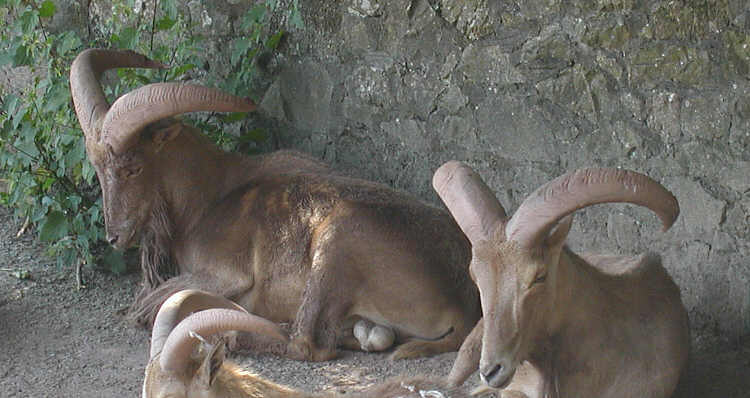- Goat-antelope
Taxobox
name = Goat-antelopes

image_width = 250px
image_caption =Barbary Sheep , "Ammotragus lervia"
regnum =Animal ia
phylum =Chordata
classis =Mammal ia
ordo =Artiodactyla
familia =Bovidae
subfamilia = Caprinae Gray, 1821 Pantholopinae
subdivision_ranks = Genera
subdivision = Subfamily Caprinae "Nemorhaedus "
"Rupicapra "
"Oreamnos "
"Budorcas "
"Ovibos "
"Hemitragus "
"Ammotragus "
"Pseudois "
"Capra"
"Ovis "
†"Bootherium"
†"Euceratherium"
†"Soergelia
Subfamily Pantholopinae "Pantholops "The term goat-antelope usually means any of thespecies of mostly medium-sizedbovid s that make up the subfamily Caprinae (as treated here). The domesticsheep and domesticgoat are both part of the goat-antelope group, and the group itself is part of the familyBovidae , which in other branches contains theantelope s and domesticcattle . "Goat antelope" also sometimes refers to theTibetan antelope .Clarifyme|date=May 2008Characteristics
Although most goat-antelopes are gregarious and have a fairly stocky build, they diverge in many other ways. For example the
Musk Ox ("Ovibos moschatus"), is adapted to the extreme cold of thetundra ; theRocky Mountain goat ("Oreamnos americanus"), ofNorth America is specialised for very rugged terrain; theUrial ("Ovis orientalis") occupies a largely infertile area fromKashmir toIran , including much desert country. TheEuropean mouflon ("Ovis musimon") is thought to be the ancestor of the moderndomestic sheep ("Ovis aries").Many species became extinct since the last
ice age , probably largely because of human interaction. Of the survivors:
*five are classified as endangered,
*eight as vulnerable,
*seven as of concern and needing conservation measures, but at lower risk, and
*seven species are secure.Members of the group vary considerably in size, from just over convert|1|m|ft|sigfig=1 long for a full-grown grey goral ("Nemorhaedus goral"), to almost convert|2.5|m|sigfig=1 long for a musk ox, and from under convert|30|kg to more than convert|350|kg. Musk oxen in captivity have reached over convert|650|kg.
In lifestyle, the caprids fall into two broad classes, "resource-defenders" which are territorial and defend a small, food-rich area against other members of the same species, and "grazers", which gather together into herds and roam freely over a larger, usually relatively infertile area.
The resource-defenders are the more primitive group: they tend to be smaller in size, dark in colour, males and females fairly alike, have long, tassellated ears, a long mane, and dagger-shaped horns. The grazers evolved more recently. They tend to be larger, highly social, and rather than mark territory with scent glands, they have highly evolved dominance behaviours. There is no sharp dividing line between the groups, but a continuum between the serows at one end of the spectrum and sheep, true goats, and musk oxen at the other.
Evolution
The goat-antelope or "caprid" group is known from as early as the
Miocene , when members of the group resembled the modernserow in their general body formcite book |editor=Macdonald, D.|author= Geist, Valerius|year=1984 |title= The Encyclopedia of Mammals|publisher= Facts on File|location=New York|pages= 584-587|isbn= 0-87196-871-1] . The group did not reach its greatest diversity until the recentice age s, when many of its members became specialised for marginal, often extreme, environments: mountains, deserts, and theSubarctic region.The ancestors of the modern sheep and goats (both rather vague and ill-defined terms) are thought to have moved into mountainous regions – sheep becoming specialised occupants of the foothills and nearby plains, and relying on flight and
flock ing for defence against predators, and goats adapting to very steep terrain where predators are at a disadvantage.Classification
FAMILY BOVIDAE
* Subfamily Caprinae
** Tribe Ovibovini
*** Genus "Budorcas "
****Takin , "Budorcas taxicolor"
*** Genus "Ovibos "
****Musk ox , "Ovibos moschatus"
** Tribe Caprini
*** Genus "Ammotragus "
****Barbary sheep , "Ammotragus lervia"
*** Genus "Capra"
****Wild goat , "Capra aegagrus"
*****Domestic goat , "Capra aegagrus hircus"
****West Caucasian tur , "Capra caucasia"
****East Caucasian tur , "Capra cylindricornis"
****Markhor , "Capra falconeri"
****Alpine ibex , "Capra ibex"
****Nubian ibex , "Capra nubiana"
****Spanish ibex , "Capra pyrenaica"
***Siberian ibex , "Capra sibirica"
****Walia ibex , "Capra walie"
*** Genus "Hemitragus "
****Nilgiri tahr , "Hemitragus hylocrius"
****Arabian tahr , "Hemitragus jayakari"
****Himalayan tahr , "Hemitragus jemlahicus"
*** Genus "Ovis "
****Argali , "Ovis ammon"
****Domestic sheep , "Ovis aries"
****American bighorn sheep , "Ovis canadensis"
**** Dall or thinhorn sheep, "Ovis dalli"
****European mouflon , "Ovis musimon"
****Snow sheep , "Ovis nivicola"
****Urial , "Ovis orientalis"
*** Genus "Pseudois "
****Bharal (Himalayan blue sheep), "Pseudois nayaur"
****Dwarf blue sheep , "Pseudois schaeferi"
** Tribe Naemorhedini
*** Genus "Capricornis "
****Japanese serow , "Capricornis crispus"
****Mainland serow , "Capricornis sumatraensis"
****Taiwan serow , "Capricornis swinhoei"
*** Genus "Nemorhaedus "
****Red goral , "Nemorhaedus baileyi"
****Chinese goral , "Nemorhaedus caudatus"
****Grey goral , "Nemorhaedus goral"
*** Genus "Oreamnos "
****Mountain goat , "Oreamnos americanus"
*** Genus "Rupicapra "
****Pyrenean chamois , "Rupicapra pyrenaica"
****Chamois , "Rupicapra rupicapra"
* Subfamily Pantholopinae
*** Genus "Pantholops "
****Chiru (Tibetan antelope), "Pantholops hodgsoni"References
Wikimedia Foundation. 2010.
